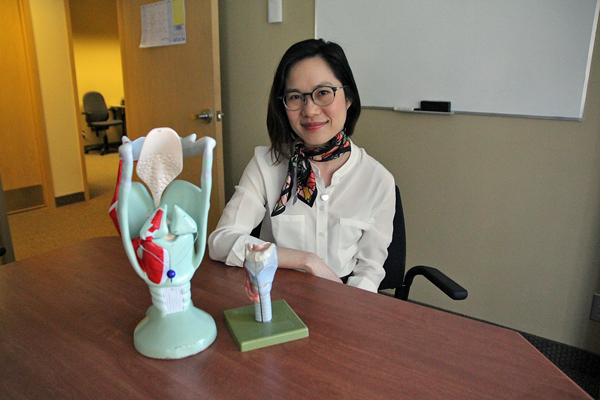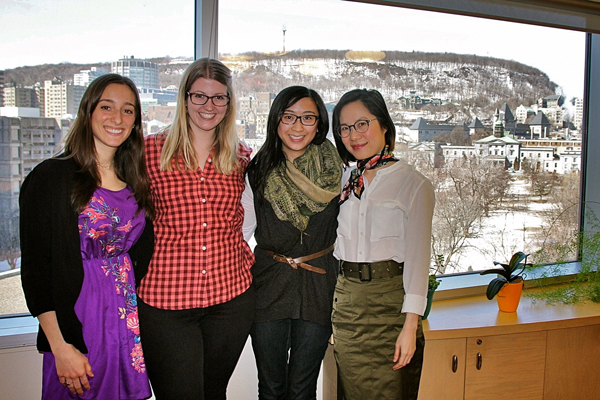
Cutting-edge approaches to voice assessment and wound healing being developed here
By Neale McDevitt
If you are a singer, a teacher, a lawyer, a coach, or anyone whose profession relies on their voice, Nicole Li may very well be your guardian angel.
A professor in the Faculty of Medicine’s School of Communication Sciences and Disorders (SCSD), Li has dedicated her research to help protect people’s voices and better heal them when problems arise. “Most people use their voice as their primary method of communication – and many people need it to earn their living,” she says. “But, surprisingly, we hear very little about good vocal hygiene and how to keep your voice healthy.”
To try and raise awareness of all things voice related, Li and her students from the SCSD are organizing a special voice seminar on April 17 , in conjunction with the Montreal General Hospital Voice Clinic, the Schulich School of Music and the Centre for Interdisciplinary Research in Music Media and Technology.
The seminar will include a real singer patient case presentation and panel discussion, singing styles demo and scientific updates on innovative voice and music research at McGill. Leading experts – including a laryngologist, a speech pathologist, singing professors and research scientists – will discuss causes, risk factors, treatment and prevention of vocal injuries commonly seen in singers, teachers or other voice professionals. The experts will also answer questions about voice from the audience.
The seminar is part of World Voice Day (WVD), a global initiative that will feature more than 300 voice-related events in 50 countries. Also as part of WVD, the SCSD organized public voice screening and workshop events earlier in April that drew 80 people to have their voices tested for possible problems and to participate in the workshop.
“The students have done a fantastic job at helping organize the WVD events,” says Li. “Students here at McGill are so engaged and so creative. I am very proud of them.”
The anatomy of a sore throat
People produce sound with their vocal folds, very delicate tissue that runs across the larynx. These vocal folds vibrate during phonation, modulating the flow of air being expelled from the lungs. The higher the pitch, the faster your vocal folds vibrate and the louder you yell or sing, the greater the impact of those vibrations. Put too much stress on your fragile vocal folds and you will injure them.

When we shout ourselves hoarse at a hockey game or wake up with a raspy voice after a long night singing karaoke, we have actually injured the soft, fragile tissue of our vocal folds. More often than not, however, we give our throats a chance to heal properly.
But for people who use their voices a lot every day – those voice professionals who don’t have the luxury of simply not talking for a few days – the problem is accumulative.
“This type of injury is similar to the type of repetitive stress injuries you can get with your wrist from using your computer,” says Li. “Sometimes it is a question of overuse combined with bad habits.”
More serious vocal issues arise when the delicate vocal folds are forced back into serious action without having fully recovered from an initial strain. What starts off as a hoarse voice or even laryngitis after a long day delivering lectures can develop into more serious problems after weeks and months of projecting one’s voice to the back of cavernous lecture halls.
And the cycle is a vicious one because once a teacher’s voice is strained they have to force it even more to be heard, further compounding the problem. It should come as no surprise that almost 60 per cent of teachers develop some sort of vocal problem over the course of their career, compared to just 20 per cent in other professions.
“People who use their voices a lot are at risk of developing lesions on their vocal folds, such as nodules,” says Li. “A nodule is kind of like a blister you’ll get on your feet if you walk a lot.”
Li says that nodules are usually very responsive to behavioural voice therapy given by speech pathologists. But other lesions, cysts and polyps, for example, are less likely to respond to speech therapy. In these cases, surgery is the only option.
But vocal fold surgery is often a double-edged scalpel as patients who have this type of microsurgery sometimes develop scars on their vocal folds. When one considers how the very functionality of the vocal folds is entirely dependent upon their suppleness, the sudden development of rigid scar tissue can be disastrous.
A case in point: In 1997, Academy Award- and Grammy-winning singer and actress Julie Andrews had surgery to remove noncancerous nodules from her vocal folds. When she awoke, her famous soprano was gone forever.
Computer model will better direct treatment choices
At present, doctors and therapists can’t predict treatment outcomes for patients. Is surgery worth the risk or would voice therapy be a better option? And, if it is the latter, what type of therapy should be used and at what frequency? The delicate nature of the vocal folds add even greater import to these choices, as the wrong treatment could cause more damage than it solves.
Li is trying to take the guesswork out of the equation by developing a computer model that will predict patients’ responses to various interventions. Li’s is the only lab in North America – maybe in the world – working on this.
“With the computational model we input the patient’s biological characteristics, their genetic background and the health status of their vocal folds,” says Li. “The model will simulate the biological process relevant to the wound repair and predict the outcome for different treatments. Basically, we run the clinical trials in the computer model.
“For example, we can play with the computer model and say ‘Okay if we increase the frequency of voice therapy will it help or will it actually make the case worse?’ says Li. “Choosing the right treatment early on can help avoid serious problems down the line.”
The other branch of Li’s research is in developing noninvasive evaluation technology for vocal fold assessments. As Li explains, certain procedures – taking a biopsy of a vocal fold lesion to determine if it is malignant, for example – can itself cause scarring that can literally leave a person speechless.
Working in conjunction with Mechanical Engineering’s Canada Research Chair, Luc Mongeau, and Paul Wiseman of the Departments of Chemistry and Physics, Li is using a technique called non-linear laser scanning to take pictures of the vocal folds. “We want to avoid any kind of incision – even the smallest ones,” says Li.
Using these images, Li is able to analyze the underlying structure of the vocal folds, namely collagen and elastin.
“The reason why scar tissue is so stiff is because there is too much collagen and the collagen fibres are disorganized,” says Li. “There is an interesting hypothesis that shows that certain voice therapies can help realign collagen in a more organized way. This could help restore the suppleness to damaged vocal folds structure.”
Simple steps can help minimize risks
But Li wants to help people avoid reaching the point where they need to make these types of decisions altogether.
She says people who use their voices a lot over the course of a day can minimize their risks of developing vocal problems by following a handful of simple strategies.
- Stay hydrated. Drink lots of water over the course of a day and, should you feel like your throat is always dry, use some sort of humidifier or vaporizer when you sleep.
- Avoid excessive use of alcohol and caffeinated beverages, which act as a diuretic.
- Avoid smoking
- Perform simple vocal warm-up and warm-down exercises at the start and end of the day.
- When possible, use a microphone if you need to project your voice in a big lecture hall
- Remember to pause during long lectures and build into your lectures periods where you can rest your voice (group discussions, etc.)
When asked what direction she sees her research taking in the future, Li says she’d like to work more closely with clinicians.
“Right now, my voice research is more at a basic science level – doing computational modeling and developing some noninvasive clinical tools. But I want to strengthen ties with the clinical community here so that I can translate my research and test it on patients and not just at the bench,” she says.
“That’s why I’m involved in World Voice Day,” she says. “No matter how good a job you may be doing, I feel like you can always do more.”
Learn more about the World Voice Day Seminar on April 17, and register for the event.
